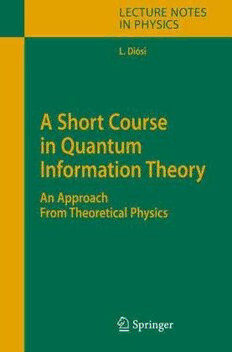Table Of ContentLecture Notes in Physics
EditorialBoard
R.Beig,Wien,Austria
W.Beiglböck,Heidelberg,Germany
W.Domcke,Garching,Germany
B.-G.Englert,Singapore
U.Frisch,Nice,France
P.Hänggi,Augsburg,Germany
G.Hasinger,Garching,Germany
K.Hepp,Zürich,Switzerland
W.Hillebrandt,Garching,Germany
D.Imboden,Zürich,Switzerland
R.L.Jaffe,Cambridge,MA,USA
R.Lipowsky,Golm,Germany
H.v.Löhneysen,Karlsruhe,Germany
I.Ojima,Kyoto,Japan
D.Sornette,Nice,France,andZürich,Switzerland
S.Theisen,Golm,Germany
W.Weise,Garching,Germany
J.Wess,München,Germany
J.Zittartz,Köln,Germany
TheLectureNotesinPhysics
TheseriesLectureNotesinPhysics(LNP),foundedin1969,reportsnewdevelopments
in physics research and teaching – quickly and informally, but with a high quality and
theexplicitaimtosummarizeandcommunicatecurrentknowledgeinanaccessibleway.
Bookspublishedinthisseriesareconceivedasbridgingmaterialbetweenadvancedgrad-
uatetextbooksandtheforefrontofresearchtoservethefollowingpurposes:
•tobeacompactandmodernup-to-datesourceofreferenceonawell-definedtopic;
•toserveasanaccessibleintroductiontothefieldtopostgraduatestudentsandnonspe-
cialistresearchersfromrelatedareas;
• to be a source of advanced teaching material for specialized seminars, courses and
schools.
Both monographs and multi-author volumes will be considered for publication. Edited
volumes should, however, consist of a very limited number of contributions only. Pro-
ceedingswillnotbeconsideredforLNP.
Volumes published in LNP are disseminated both in print and in electronic formats,
the electronic archive is available at springerlink.com. The series content is indexed,
abstracted and referenced by many abstracting and information services, bibliographic
networks,subscriptionagencies,librarynetworks,andconsortia.
ProposalsshouldbesenttoamemberoftheEditorialBoard,ordirectlytothemanaging
editoratSpringer:
Dr.ChristianCaron
SpringerHeidelberg
PhysicsEditorialDepartmentI
Tiergartenstrasse17
69121Heidelberg/Germany
[email protected]
Lajos Diósi
A Short Course
in Quantum
Information Theory
An Approach From Theoretical Physics
ABC
Author
Dr.LajosDiósi
KFKIResearchInstitutefor
ParticalandNuclearPhysics
P.O.Box49
1525Budapest
Hungary
E-mail:[email protected]
L. Diósi, A Short Course in Quantum Information Theory, Lect. Notes Phys. 713
(Springer,BerlinHeidelberg2007),DOI10.1007/b11844914
LibraryofCongressControlNumber:2006931893
ISSN0075-8450
ISBN-10 3-540-38994-6SpringerBerlinHeidelbergNewYork
ISBN-13 978-3-540-38994-1SpringerBerlinHeidelbergNewYork
Thisworkissubjecttocopyright.Allrightsarereserved,whetherthewholeorpartofthematerialis
concerned,specificallytherightsoftranslation,reprinting,reuseofillustrations,recitation,broadcasting,
reproductiononmicrofilmorinanyotherway,andstorageindatabanks.Duplicationofthispublication
orpartsthereofispermittedonlyundertheprovisionsoftheGermanCopyrightLawofSeptember9,
1965,initscurrentversion,andpermissionforusemustalwaysbeobtainedfromSpringer.Violationsare
liableforprosecutionundertheGermanCopyrightLaw.
SpringerisapartofSpringerScience+BusinessMedia
springer.com
(cid:1)c Springer-VerlagBerlinHeidelberg2007
Theuseofgeneraldescriptivenames,registerednames,trademarks,etc.inthispublicationdoesnotimply,
evenintheabsenceofaspecificstatement,thatsuchnamesareexemptfromtherelevantprotectivelaws
andregulationsandthereforefreeforgeneraluse.
Typesetting:bytheauthorandtechbooksusingaSpringerLATEXmacropackage
Coverdesign:WMXDesignGmbH,Heidelberg
Printedonacid-freepaper SPIN:11844914 54/techbooks 543210
Preface
Quantuminformationhasbecomeanindependentfastgrowingresearchfield.There
are new departments and labs all around the world, devoted to particular or even
complex studies of mathematics, physics, and technology of controlling quantum
degrees of freedom. The promised advantage of quantum technologies has obvi-
ously electrified the field which had been considered a bit marginal until quite re-
cently.Before,manyfoundationalquantumfeatureshadneverbeentestedorused
onsinglequantumsystemsbutonensemblesofthem.Illustrationsofreduction,de-
cay, or recurrence of quantum superposition on single states went to the pages of
regulartext-books,withoutbeingexperimentallytestedever.Nowadays,however,a
youngestgenerationofspecialistshasimbibedquantumtheoreticalandexperimen-
talfoundations“frominfancy”.
From 2001 on, in spring semesters I gave special courses for under- and post-
graduatephysicistsatEötvösUniversity.Thetwelvelecturescouldnotincludeall
standardchaptersofquantuminformation.Myguidingprincipleswerethoseofthe
theoreticalphysicistandthebelieverintheunityofphysics.Iachievedadecentbal-
ance between the core text of quantum information and the chapters that link it to
theedificeoftheoreticalphysics.Scholarlyexperienceofthepassedfivesemesters
willbeutilizedinthisbook.
Isuggestthisthinbookforallphysicists,mathematiciansandotherpeoplein-
terested in universal and integrating aspects of physics. The text does not require
special mathematics but the elements of complex vector space and of probability
theories. People with prior studies in basic quantum mechanics make the perfect
readers.Forthosewhoarepreparedtospendmanytimesmorehourswithquantum
informationstudies,therehavebeenexhaustivemonographswrittenbyPreskill,by
NielsenandChuang,ortheeditedonebyBouwmeester,Ekert,andZeilinger.And
foreachofmyreaders,itisalmostcompulsorytofindandreadasecondthinbook
“ShortCourseinQuantumInformation,approachfromexperiments”...
Acknowledgements Ibenefitedfromtheconversationsand/orcorrespondencewith
JürgenAudretsch,AndrásBodor,ToddBrun,TovaFeldmann,TamásGeszti,Thomas
Konrad,andTamásKiss.Iamgratefultothemallforthegeneroushelpanduseful
remarksthatservedtoimprovemymanuscript.
VI Preface
ItisapleasuretoacknowledgefinancialsupportfromtheHungarianScientific
ResearchFund,GrantNo.49384.
Budapest, LajosDiósi
February2006
Contents
1 Introduction................................................... 1
2 Foundationsofclassicalphysics.................................. 5
2.1 Statespace ................................................ 5
2.2 Mixing,selection,operation.................................. 5
2.3 Equationofmotion ......................................... 6
2.4 Measurements ............................................. 6
2.4.1 Projectivemeasurement............................... 7
2.4.2 Non-projectivemeasurement .......................... 9
2.5 Compositesystems ......................................... 9
2.6 Collectivesystem .......................................... 11
2.7 Two-statesystem(bit)....................................... 11
Problems ...................................................... 12
3 Semiclassical—semi-Q-physics ................................. 15
Problems ...................................................... 16
4 Foundationsofq-physics........................................ 19
4.1 Statespace,superposition.................................... 19
4.2 Mixing,selection,operation.................................. 20
4.3 Equationofmotion ......................................... 20
4.4 Measurements ............................................. 21
4.4.1 Projectivemeasurement............................... 22
4.4.2 Non-projectivemeasurement .......................... 23
4.4.3 Continuousmeasurement ............................. 24
4.4.4 Compatiblephysicalquantities......................... 25
4.4.5 Measurementinpurestate............................. 26
4.5 Compositesystems ......................................... 27
4.6 Collectivesystem .......................................... 29
Problems ...................................................... 29
5 Two-stateq-system:qubitrepresentations ........................ 31
5.1 Computational-representation ................................ 31
5.2 Paulirepresentation......................................... 32
5.2.1 Statespace.......................................... 32
VIII Contents
5.2.2 Rotationalinvariance ................................. 33
5.2.3 Densitymatrix ...................................... 34
5.2.4 Equationofmotion................................... 35
5.2.5 Physicalquantities,measurement....................... 35
5.3 Theunknownqubit,AliceandBob............................ 36
5.4 RelationshipofcomputationalandPaulirepresentations .......... 37
Problems ...................................................... 37
6 One-qubitmanipulations ....................................... 39
6.1 One-qubitoperations........................................ 39
6.1.1 Logicaloperations ................................... 39
6.1.2 Depolarization,re-polarization,reflection................ 40
6.2 Statepreparation,determination .............................. 42
6.2.1 Preparationofknownstate,mixing ..................... 42
6.2.2 Ensembledeterminationofunknownstate ............... 43
6.2.3 Singlestatedetermination:no-cloning................... 44
6.2.4 Fidelityoftwostates ................................. 44
6.2.5 Approximatestatedeterminationandcloning............. 45
6.3 Indistinguishabilityoftwonon-orthogonalstates ................ 45
6.3.1 Distinguishingviaprojectivemeasurement............... 46
6.3.2 Distinguishingvianon-projectivemeasurement........... 46
6.4 Applicationsofno-cloningandindistinguishability .............. 47
6.4.1 Q-banknote ......................................... 47
6.4.2 Q-key,q-cryptography................................ 48
Problems ...................................................... 50
7 Compositeq-system,purestate .................................. 53
7.1 Bipartitecompositesystems.................................. 53
7.1.1 Schmidtdecomposition ............................... 53
7.1.2 Statepurification..................................... 54
7.1.3 Measureofentanglement.............................. 55
7.1.4 Entanglementandlocaloperations...................... 56
7.1.5 Entanglementoftwo-qubitpurestates................... 57
7.1.6 Interchangeabilityofmaximalentanglements............. 58
7.2 Q-correlationshistory....................................... 59
7.2.1 EPR,Einstein-nonlocality1935 ........................ 59
7.2.2 Anon-existinglinearoperation1955.................... 60
7.2.3 Bellnonlocality1964................................. 62
7.3 ApplicationsofQ-correlations................................ 64
7.3.1 Superdensecoding ................................... 64
7.3.2 Teleportation........................................ 65
Problems ...................................................... 67
Contents IX
8 Allq-operations................................................ 69
8.1 Completelypositivemaps ................................... 69
8.2 Reduceddynamics ......................................... 70
8.3 Indirectmeasurement ....................................... 71
8.4 Non-projectivemeasurementresultingfromindirectmeasurement.. 73
8.5 EntanglementandLOCC .................................... 74
8.6 Openq-system:masterequation .............................. 75
8.7 Q-channels................................................ 75
Problems ...................................................... 76
9 Classicalinformationtheory..................................... 79
9.1 Shannonentropy,mathematicalproperties...................... 79
9.2 Messages ................................................. 80
9.3 Datacompression .......................................... 80
9.4 Mutualinformation......................................... 82
9.5 Channelcapacity........................................... 83
9.6 Optimalcodes ............................................. 83
9.7 Cryptographyandinformationtheory.......................... 84
9.8 Entropicallyirreversibleoperations............................ 84
Problems ...................................................... 85
10 Q-informationtheory........................................... 87
10.1 VonNeumannentropy,mathematicalproperties ................. 87
10.2 Messages ................................................. 88
10.3 Datacompression .......................................... 89
10.4 Accessibleq-information .................................... 91
10.5 Entanglement:theresourceofq-communication................. 91
10.6 Entanglementconcentration(distillation)....................... 93
10.7 Entanglementdilution....................................... 94
10.8 Entropicallyirreversibleoperations............................ 95
Problems ...................................................... 96
11 Q-computation ................................................ 99
11.1 Parallelq-computing........................................ 99
11.2 Evaluationofarithmeticfunctions.............................100
11.3 Oracleproblem:thefirstq-algorithm ..........................101
11.4 Searchingq-algorithm.......................................103
11.5 Fourieralgorithm...........................................104
11.6 Q-gates,q-circuits..........................................105
Problems ......................................................106
Solutions ..........................................................109
References.........................................................123
Index .............................................................125
Symbols, acronyms, abbreviations
{ , } Poissonbracket ◦ composition
[ , ] commutator × Cartesianproduct
(cid:1) (cid:2) expectationvalue ⊗ tensorproduct
Oˆ matrix tr trace
Oˆ† adjointmatrix trA partialtrace
⊕ modulosum
x,y,... phasespacepoints w weightinmixture
Γ phasespace |↑(cid:2),|↓(cid:2) spin-up,spin-downbasis
ρ(x) phasespacedistribution, n,m... Blochunitvectors
classicalstate |n(cid:2) qubitstatevector
x,y... binarynumbers s qubitpolarizationvector
xn...x2x1 binarystring σˆx,σˆyσˆz Paulimatrices
ρ(x) discreteclassicalstate σˆ vectorofPaulimatrices
M operation a,b,α,... realspatialvectors
T polarizationreflection ab realscalarproduct
I identityoperation xˆ qubithermitianmatrix
L Lindbladgenerator X,Y,Z onequbitPauligates
A(x),A(x) classicalphysicalquantities H Hadamardgate
H(x) Hamiltonfunction T(ϕ) phasegate
P indicatorfunction F fidelity
Π(x),Π(x) classicaleffect E entanglementmeasure
H Hilbertspace S(ρ),S(p) Shannonentropy
d vectorspacedimension S(ρˆ) vonNeumannentropy
|ψ(cid:2),|ϕ(cid:2),... statevectors (cid:1)S(ρ(cid:1)(cid:2)(cid:8)ρ(cid:1)),S((cid:2)ρˆ(cid:1)(cid:8)ρˆ)relativeentropy
(cid:1)ψ|,(cid:1)ϕ|,... adjointstatevectors (cid:1)Ψ± ,(cid:1)Φ± Bellbasisvectors
(cid:1)ψ|ϕ(cid:2) complexinnerproduct |x(cid:2) computationalbasisvector
(cid:1)ψ|Oˆ|ϕ(cid:2) matrixelement Mˆ Krausmatrices
n
ρˆ densitymatrix,quantumstate |n;E(cid:2) environmentalbasisvector
Aˆ quantumphysicalquantity X,Y,... classicalmessage
Hˆ Hamiltonian H(X),H(Y) Shannonentropy
Pˆ hermitianprojector H(X|Y) conditionalShannonentropy
Iˆ unitmatrix I(X:Y) mutualinformation
Uˆ unitarymap C channelcapacity
Πˆ quantumeffect ρ(x|y) conditionalstate
p probability ρ(y|x) transferfunction
q- quantum LO localoperation
cNOT controlledNOT LOCC localoperationand
classicalcommunication

